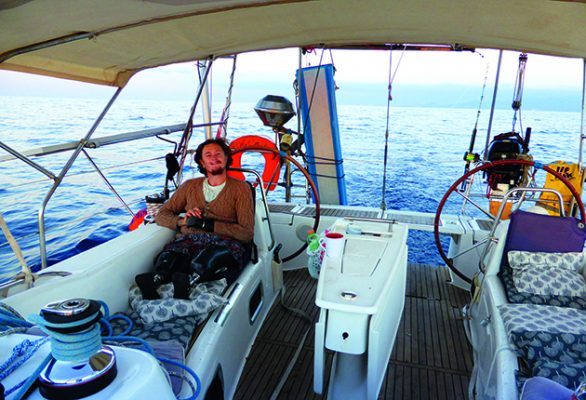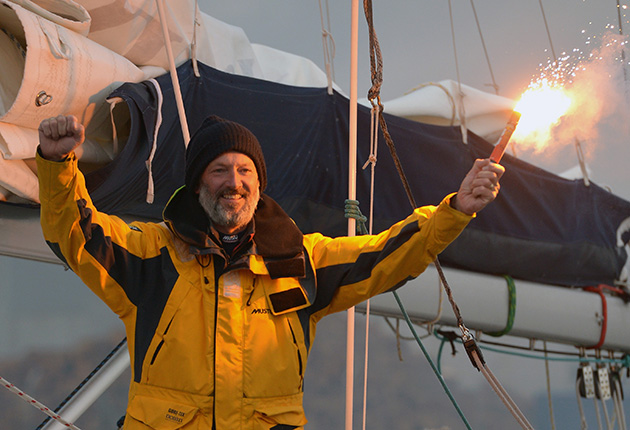Triple amputee army veteran Craig Wood is cruising around the world to raise awareness of sailing with disabilities. He shared his story with Katy Stickland
Three months after his 18th birthday, Craig Wood’s life changed forever while on deployment to his first war zone.
During a routine patrol with 2nd Battalion, The Rifles, in Helmand Province, Afghanistan, a remote IED was triggered, blowing Craig up.
The explosion resulted in the amputation of both of his legs above the knee and his left hand an inch above the wrist.
He also had extensive facial injuries and shrapnel wounds on his body.

Craig learned to sail in dinghies. A day sail on a yacht in 2015 planted the idea to circumnavigate the world. Credit: Craig Wood
It took Craig Wood eight months to learn to walk again, with a further four years rehabilitation at Headley Court, the UK’s leading rehabilitation centre for injured soldiers based outside of Leatherhead in Surrey.
‘I remember seeing a white flash and one of my friends running towards me shouting my name but I blacked out after that. Two weeks later I woke up from my medically induced coma in Birmingham Sellyoak Hospital surrounded by my family. Then I had to figure out the extent of my injuries.
‘I’d say it took around a year and a half to fully accept what had happened. I went from being an 18-year-old in his prime to a wheelchair-bound man and it had a big effect on me mentally,’ says Craig.
‘But once I accepted it, my recovery started. I began wearing prosthetics on my legs and my left hand. And now I use them everyday while on the boat.’

Craig spent years at Headley Court rehabilitation centre, where he was visited by the Duchess of Cornwall. He was determined to walk again. Credit: Getty
The 30-year-old skipper grew up in landlocked Woodlands, a village three miles north of Doncaster in South Yorkshire.
His father, Paul, taught him to sail an optimist at the age of six during one of their regular visits to the family caravan on a lake near Bridlington.
He then moved on to Toppers and Lasers before a passion for windsurfing led him to temporarily turn his back on sailing.
While Craig was recovering at the Headley Court rehabilitation centre, his father contacted a Paralympic coach, who in turn arranged a taster session for Craig on a 2.4mR.
The healing power of sailing for Craig Wood
‘I immediately loved it and how accessible it was but it wasn’t until a year later I got my own boat with assistance from Help for Heroes,’ recalled Craig.
He spent two years sailing 2.4mRs in competitions before switching to the Sonar class, where his friends Steve Palmer and Liam Cattermole joined him as crew.
Again, the charity Help for Heroes stepped in and secured the funding for the keelboat.
‘I believe sailing helped me overcome my injuries because it was something I could do before I was injured and the competition was a great motivator,’ explained Craig.
With their sights set on the 2020 Paralympic Games in Tokyo, the trio competed in the world circuit, including the Para World Championships, which took them to Miami, the Netherlands, Lake Garda in Italy, Australia and Canada.

Craig competed on the paralympic Sonar circuit before the class was dropped. Credit: Paul Wyeth
But in January 2015, Craig Wood received the news that sailing was being dropped from the Paralympics due to a lack of countries taking part.
The 2016 Rio Paralympics would be their ‘only and last shot’ at a medal, but they missed out on selection.
‘We had really gone for it, training three weeks out of every four but it wasn’t enough and the other team went to Rio in 2016. It was extremely disappointing. The decision to cancel Paralympic sailing was totally unexpected and left me wondering what to do with my life,’ said Craig.
While in Melbourne for the 2015 Para World Sailing Championships, he spent an afternoon sailing on a yacht and ‘immediately fell in love with the idea of sailing around the world.’
With the seed of a circumnavigation planted, Craig Wood began actively searching for the ideal boat.

Renate and Craig sailing in Punta Hromic in Patagonia. Credit: Craig Wood
By April 2016, he had bought a Colvic Victor 40, Never Ending Story, believing a ‘heavy displacement boat would be better suited to my disability’, as it offered him more stability.
He spent months refitting the yacht at Fox’s Marina and Boatyard on the River Orwell before leaving to chase his dream of sailing around the world in April 2017, a day after his 26th birthday.
After a year of cruising Never Ending Story to the Mediterranean, Craig had changed his mind about the yacht and instead wanted a boat with better sailing performance.
Continues below…
Hell or High Seas: a voyage around Cape Horn
Taylor Grieger and Stephen O’Shea faced pirates, navigated the Furious Fifties and came to blows during a life-changing voyage from…
Gerry Hughes: no challenge too great
Gerry Hughes is the first deaf sailor to solo circumnavigate the world. Katy Stickland finds out what motivates him to…
The best sail plans for crossing an ocean
Sailing across an ocean, there are myriad sail plans to choose from to power you across an ocean. We spoke…
Family sailing: The secrets of cruising with kids
As sailors, you’re likely to share your passion with your nearest and dearest. Family sailing offers the promise of quality…
‘I realised I had sailed all the way to Greece, mainly under engine, and a feeling of guilt was creeping up on me; this was supposed to be about sailing and here we were motoring all of the time. I decided I was going to get a boat better suited to light winds and try to sail her around Cape Horn,’ he explained.
In Lefkada, he found the Beneteau Oceanis 46, Sirius.
Having made improvements to the boat’s electrics and solar panels, he continued his voyage, sailing either solo or with crew – friends and family or other travellers looking to sail to new places.
He has also offered other army veterans the chance to sail, providing ‘a little bit of escapism’ to those coming to terms with post-traumatic stress disorder.
Cruising with crew helps with the fiddly two-handed jobs onboard as Craig has made no modifications to Sirius.

Craig sailed solo and with crew in Europe, Africa and South America. Credit: Craig Wood
He can’t climb the mast on his own or hold nuts and screws, but says ‘you figure out a way’ to solve any issue.
If sailing solo, he usually finds help from another friendly skipper nearby.
While in Gibraltar in December 2018, he met Renate Gwerder, who was hitchhiking to South America.
The Swiss interior architect remained onboard Sirius until Brazil, sailing the yacht down the coast of Africa to Cape Verde and then across the Atlantic to Salvador.
By now Craig and Renate were a couple, and continued down the Brazilian coast to Rio de Janeiro, where they left the boat for three months; Craig flew back to the UK and Renate continued backpacking around South America.

Renate at the bow of Sirius at Isla Tovo in Argentina. Credit: Craig Wood
Craig’s return to Brazil had a sting in the tail.
A paperwork error meant Sirius had been impounded by the Brazilian authorities and Craig was left facing a £10,000 bill to release his boat.
‘One of the biggest challenges of the circumnavigation has been the bureaucracy of checking in and out of different countries, especially when you don’t speak the language. The £10,000 fine due to a paperwork error has been the lowest point of the voyage so far, and once paid I had to leave Brazil in 30 days,’ he shared.
But, every cloud has a silver lining.
Having to leave Brazil so soon meant Craig would have to sail 1,000 miles south to Uruguay, solo.
He relished the challenge, and he broke the voyage into three legs, the longest being the last one – 600 miles from Enseada Da Pinheira to Piriápolis, on Uruguay’s Atlantic coast.
‘There was some pressure as I was stuck in Enseada Da Pinheira for a week due to adverse winds. I managed to leave with eight days to spare before my month in Brazil was up. It was a lovely trip and certainly a high point so far,’ said Craig.
Renate rejoined the boat in Uruguay and they continued south.

Anchored at Bahia Tres Brazos, Patagonia in the Beagle Channel. Credit: Craig Wood
By Christmas 2019, they were in Mar del Plata in Argentina before moving on to Puerto Deseado.
The sovereignty of the Falkland Islands is still a sensitive subject in Argentina, as Craig found out when he inquired about sailing there.
‘A permit is needed to sail from Argentina to the Falklands and this takes a month so we decided to check out of Argentina and just sail the four-day passage there. It was one of the hairiest sails I’ve ever had. We had just left Puerto Deseado when we were hit with a strong gust off the land. Within a minute the waves were huge and the wind rounded the boat side on to the waves. I was very worried we would roll, but a quick reef in the genoa and motoring for 10 minutes had us hove to and we were fine. The wind shortly died back down to its original 15 knots.’
From the Falkland Islands, Craig and Renate arrived at Tierra del Fuego and then Puerto Williams in Chile to prepare for a passage around Cape Horn, but the weather was too bad and instead, they sailed through the Beagle Channel and up the Pacific coast of Chile.
By now, COVID-19 was beginning to make itself felt in South America, so the couple stopped in Puerto Montt, where they remained for four months.
Hope in an uncertain world
By October 2020 they had reached Robinson Crusoe Island, 362 miles west of San Antonio, Chile, where they stayed for a week, unable to land ashore because of the pandemic, before sailing to Ecuador.
Time was pressing to head north as Renate was now pregnant.
She returned home while Craig sailed solo to Panama, where Renate joined him to prepare for the birth of their son.
Amaru was born onboard Sirius in the Vista Mar Marina, outside Panama City in April.
‘We had planned for Renate to give birth onboard. We had a midwife on hand in case anything went wrong, and there was lots of music to help keep Renate calm. It was a super crazy experience. Nothing in my life so far can compare to it; it was just pure magic,’ said Craig.

Renate and Craig’s son, Amaru was born onboard their Beneteau Oceanis 46 in Panama City. Credit: Craig Wood
Just weeks later the new family sailed their first voyage from Panama City south to Isla Boná, a protected nature reserve in the Gulf of Panama.
Craig Wood doesn’t consider himself inspirational, but does hope his circumnavigation will help others realise they can achieve their dreams.
‘It’s a message of owning your narrative and still being able to achieve things people might find hard to believe. My advice is don’t expect too much then the surprises are all the better.’
For a man who doesn’t expect too much, life has certainly provided Craig Wood with plenty of incredible surprises.
Craig, Renate and Amaru’s circumnavigation of the world can be followed via facebook.com/FloatingNestSirius, their website www.captaincraig.co.uk and their You Tube channel Captain Craig








